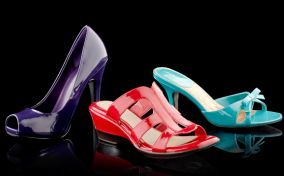Fix broken heels, repair tears and make scuff marks disappear. We have
expert tips to keep your favorite footwear looking spiffy and new!
There are just some times when being able to do some simple shoe repairs
can really pay off…not only in time but in money.
Here are some simple considerations for basic repairs at home:
Broken or Worn Down Heels
One of the very first things you can do to help extend the life of your flat
heeled dress shoes is to purchase a heel tip or heel cap attachment. Often
they are shaped like a kidney bean and about 1 inch across. Some of them
come pre-glued and others have a small staple you nail in. Check with a
shoe repair shop, the shoe department of a nice department store, or even
some craft stores carry them.
For high heels that are completely worn down there are hard rubber
replacement tips that can be purchased in a few different sizes depending on
the style of shoe. Be sure to follow the manufacturer’s replacement
instructions for the specific heel tip you have purchased. Typically it is a
matter of pulling out the old heel tip with pliers and then reinserting the new
heel tips with a little glue and a hammer.
For men’s heels in dress leather shoes the following steps will be helpful:
Step 1. Remove any nails or screws that are used to keep the old heel in
place. The old heel should come off with a few forceful tugs. Do not worry if
you break the old heel in the process of removing it.
Step 2. Use the file (or sandpaper) to scuff the area of the shoe where the
new heel will be attached and the surface of the replacement heel that will
butt against that area of the shoe. This is your chance to remove any glue or
gunk and to repair the leather.
Step 3. Apply shoe-repair contact cement to the area on the shoe where you
will attach the heel. Carefully line up the replacement heel. Press the heel
firmly to the shoe.
Step 4. Once the glue has dried, reinforce the new heel with several nails or
screws. Use the old heel as your guide. Be careful not to apply nails or screws
too close to the edge of the heel as this will weaken the heel and make it
more likely to break.
Step 5. Use a file to remove any rough edges or glue residue.
Scuffs or Tears to the Leather
Scuffs, or tears to the leather, are a common occurrence, and maddening too.
If the leather is actually torn and lifting up, simply glue it back down with a
tiny bit of strong glue. Then if needed, smooth over with a matching color of
acrylic paint or polish.
On a scuff, the fibers can be glued back down a bit by simply putting a small
amount of glue on your finger tip and smoothing down the tiny fiber that
lifted in the scuffing process. Then, when that is dry paint or polish over the
mark. Works like a charm.
Note: There is a shoe glue that is called Shoe Goo… it is available for only a
few dollars and can seal cracks and splits in leather, rubber, and most other
man-made materials that may be found in a shoe’s composition…it can be
used for a number of things associated with repairs to shoes. It can be used
to rebuild worn out soles, repair holes in rubber waders and galoshes, repair
damaged heels, repair insoles, reinforce skate shoes, and even coat skate
boards for better traction.
General Care Tips
Caring for our shoes is not just about making them look “new” again, but
about extending the life of the shoe—and with the cost of good shoes these
days, that is reason enough in my book. Wouldn’t it be nice to find out that,
thanks to appropriate care, your shoes look as if they were brand new after
two, three, or four, years?
No matter what type of shoe we are talking about, there are small and simple
things we can do to extend the life and improve the look of our shoes. They
are:
– Clean your shoes regularly. Never leave mud on them for a long time.
– Condition your footwear. Almost any material used in shoemaking requires
conditioning.
– Polishing is necessary. If you have velvet shoes or some other that do not
allow polishing, use special tools to make them glow.
– Preserve the shoe in the manner that is best for the material of the shoe.
By “preserving” we mean weatherproofing and waterproofing—with effective
products for your different shoes, as well as deodorizing and shaping.
While it is possible to take your shoes to a shoe repair shop to be cleaned
and polished-it is possible to do many things at home. Here are some ideas:
Cleaning and Polishing Shoes
Only a few items are necessary:
· Natural bristle brush
· Old toothbrush or q-tip
· Shoe Cleaners
· Wax or cream polish
· Soft cotton cloth or rag
· Newspaper or an old sheet
Shoe cleaners come in gels, foams, sprays, liquids and creams. Many leather
cleaners come with an applicator top, or you can use a soft shoe brush to aid
in removing dirt from the surface of the shoe. This will also help to remove
dirt from any cracks in the shoes. One of the most common leather cleaners
is saddle soap.
Leather Shoes
First, remove the laces—if applicable. Next, use a brush or damp cloth to
clean dust or dirt from the shoe, heel and sole. Select a polish that matches
your shoe color. Polishes that contain dyes, pigments, wax and conditioning
agents keep footwear looking fresh, add shine and cover scuffs. They are
available as liquid, paste (used for the sturdier/heavy leather shoes) and
cream(used for the very soft kid skin leather shoes). Although liquid polishes,
with their foam applicator tops, are easiest to work with, shoe repair experts
recommend the protection and conditioning offered by creams and pastes —
liquid polishes can dry out shoe leather and cause cracking.
With a soft cloth, apply a small amount of polish in a circular pattern. An old
toothbrush or q-tip is useful for getting polish into small or tight areas. Place
the polished shoes on newspaper or an old sheet to dry. When the shoe is
dry, usually after about 15 minutes, brush with a natural bristle brush, then
buff to a shine with a clean rag. If you are polishing several pairs of shoes, be
sure to use a different brush and rags for each color of polish.
Cleaning Suede and Nubuck Shoes
Shoes with a nap, such as suede or nubuck, can’t be polished. According to
the Shoe Service Institute of America, preventive maintenance is the key to
keeping these types of shoes in top shape. After purchasing a pair of suede
or nubuck shoes, you’ll first want to apply a protectant to repel water and
stains. However, repellant only lasts for a while, so you’ll need to reapply it
periodically. Gently brush suede and nubuck footwear to remove loose dirt
and restore nap on a regular basis. If you own a pair of oiled nubuck shoes,
you may also want to apply conditioner to preserve them. Stains should be
treated immediately with a solvent based suede cleaner. If they prove hard to
remove, take the shoe to a shoe repair professional.
Caring for Athletic Shoes and Sneakers
Athletic shoes with fabric or suede uppers and trim can be cleaned the same
way you clean your suede or nubuck shoes. Special sneaker shampoos, used
with brush applicators, do a good job of cleaning stains and dirt from leather
sneakers. Cover scuff marks with matching polish. Sneakers made from
canvas, such as Converse All Stars, can be washed by hand using a
toothbrush, mild soap and water.
Two Cautions: If you decide to look after your shoes yourself, make sure you
take all the necessary precautions before you start. First, the area you are
working in should be properly ventilated. Secondly, use gloves to protect
skin. Many shoe care products consist of toxic ingredients to improve
efficiency and thus may be somewhat harmful.
Read the instructions given on the product’s package carefully. Before you
apply it on your favorite pair of shoes, make sure it was designed for the type
of the material your shoes are made of. If you use a product for the leather
shoe care on a suede shoe, the consequences may be disastrous.
Here are a few more shoe care tips for additional materials:
Velvet:
– Velvet should be cleaned with dry cloth ONLY, as water will ruin the
material. To remove dirt, rub the shoes gently avoiding round moves.
Mesh materials:
– Use damp sponge to clean the upper material.
– Use waterproof products to protect the fabrics from water.
Miscellaneous Fabrics:
– Use damp sponge or dry cloth to clean the upper material.
– In case you are uncertain, use dry cloth to remove dirt, rubbing the material
gently.
– Use invisible colorless products to protect your shoes from water and dirt.
Other Preserving Tips:
1. Organize your shoe storage—boxes, racks, or stands. It is not a good idea
to have them all piled on top of each other in the bottom of the closet—this
does not allow them to breath or to maintain proper shape.
2. Also make sure there are no direct sunrays hitting your footwear—this will
dry out, crack, fade, and weaken the fibers of your shoes.
3. Some heel repair can be done at home—Crazy Glue, Super Glue, and Shoe
Goo are all options for helping to mend and repair heels—depending on the
problem and the heel. Take shoes to a repair shop for re-soling and heel
repair.
4. Heel tips and heel caps can extend the life of your shoe.
5. Often, it is possible to repair squeaky shoes at home too.
6. Use a shoe deodorizer to help preserve/extend the life of the shoe.
Remember that if you take care of your shoes the way needed, they will serve
you for many years to come, and every time you put them on will be a
pleasant and comfortable experience.
Resources:
If you have any questions, contact Teresa Hunsaker at the Family and
Consumer Science Education Department at the Weber County USU Extension
office at (801) 399-8203 or online at extension.usu.edu/weber/















Add comment